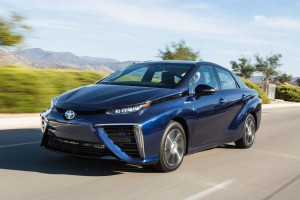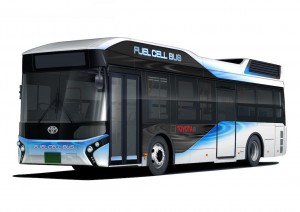
Toyota's Mirai fuel-cell vehicle is part of Japan's push to get 40,000 fuel cell vehicles on Japanese roads by the end of the decade.
With the next Olympics fast approaching, the Japanese government is racing to put in place what it hopes will be the world’s most advanced, hydrogen-based highway infrastructure, and it’s getting a helping hand from the country’s three largest automakers and a number of other large companies.
Japan has laid out a plan to have 40,000 hydrogen-powered cars on its roads by the end of the decade, the number expected to jump to 200,000 by 2025 and 800,000 by 2030. It also wants to set up a network of nearly 1,000 fueling stations to support those vehicles.
But getting there won’t be easy, even proponents acknowledge. Though three manufacturers now offer fuel-cell-powered vehicles on the retail market, there are only about 1,800 FCVs on the road in Japan, according to industry data, and barely 4,000 worldwide.
The government laid out broad plans – which would also include hydrogen buses – last month. On Friday, it expanded its strategy by announcing that Toyota, Nissan and Honda, as well as a number of energy and gas companies, as well as a major Japanese bank, had agreed to collaborate on the effort.
Two of the three automakers have already launched hydrogen-powered vehicles, Toyota last year introducing its Mirai model in Japan, the U.S. and several other markets. Honda recently joined in with the Clarity FCV. The smaller maker actually was the world’s first to commercially offer a hydrogen car to retail consumers, albeit in extremely limited numbers a decade ago.
Not that the Mirai and Clarity have gone mainstream. Sales have barely measured in the hundreds since their debut. That is, in part, due to the lack of a supportive refueling infrastructure. In the U.S., all three hydrogen cars – which includes a version of the Hyundai Tucson – are offered only in a few, select regions in California where there are public hydrogen pumps.

Toyota plans to introduce over 100 FC buses mainly in the Tokyo area, ahead of the Tokyo 2020 Olympic and Paralympic Games.
(Click Here for more on Toyota’s fuel-cell truck project.)
The Golden State hopes to have as many as 100 in place by the end of this decade. Japan wants to go even further, the new project targeting 900 retail refueling stations across the country by 2030.
Proponents believe hydrogen has some appealing advantages over battery-based powertrain technologies. The range of the three current models is about 300 miles per tank, and refueling takes about five minutes, about the same as a gasoline-powered vehicle, rather than the hours needed to complete recharge batteries.
Fuel costs are high but starting to come down, a member of the Honda Clarity teams recently telling TheDetroitBureau.com that the target is to have price parity between gasoline and hydrogen within the next three to five years.
Nonetheless, Japan is expecting to offer hefty incentives to encourage more companies to participate in its hydrogen vision, especially energy providers and vehicle manufacturers. Nissan is signaling it will launch a hydrogen vehicle by its participation in the project.
“I think Japan is in the lead,” Hiroshi Katayama, deputy director for advanced energy systems at the country’s Ministry of Economy, Trade and Industry, told Automotive News last month.
But California is pushing hard to promote hydrogen power, as are Germany and South Korea.
(Click Here for a review of the hydrogen-powered 2017 Honda Clarity FCV.)
A number of foreign makers are also working on the technology – which combines hydrogen with oxygen from the air in a device called a fuel-cell stack. The system produces a flow of current to power the same sort of motors used in electric vehicles. There is a tailpipe, but the only exhaust gas is water vapor.
Among other makers looking to get into the segment are Daimler, BMW and General Motors. Earlier this year, GM entered into a joint venture with Honda to manufacture fuel-cell stacks in the U.S. It has not, however, announced when it will roll out a vehicle using that system.
Even among the automakers which have been developing hydrogen technology, there is some skepticism. Daimler CEO Dieter Zetsche has said his company is putting more emphasis on battery drive. Ford global product and technology chief Raj Nair has also said the Detroit maker is easing back on fuel-cell development, though it continues R&D work.
Even Toyota, which had long been a lithium-ion skeptic, has been moving research dollars from hydrogen to battery development, several officials have told TheDetroitBureau.com in recent weeks.
The new Japanese consortium is likely to serve as a measure of how far hydrogen power will go. The 11 partners will initially focus on ways to reduce costs, and simplify the regulatory process. And they aim to “support hydrogen-station construction and operation,” according to a statement. There are 98 stations in Japan either in operation or now under construction.
(Toyota fuel cell buses ready for Tokyo testing. Click Here for the story.)
Longer-term, the consortium will “consider ways for broad participation by other companies,” though it isn’t clear if foreign automakers will be asked to participate.
